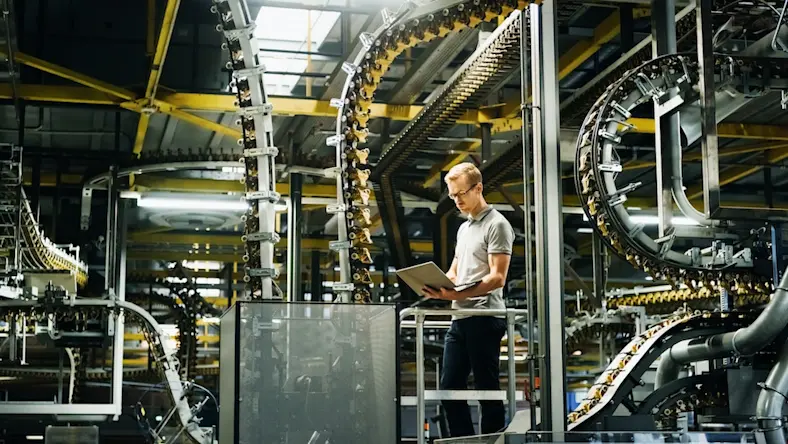& Construction

Integrated BIM tools, including Revit, AutoCAD, and Civil 3D
& Manufacturing

Professional CAD/CAM tools built on Inventor and AutoCAD
The picture of a traditional factory—massive buildings, lengthy production lines, and workers focused on individual tasks—is shrinking, literally. Microfactories are scaled-down manufacturing solutions that can evolve through rapid prototyping and innovation to produce highly customized products with lower costs and greater flexibility than the standard manufacturing model.
As their name suggests, microfactories are much smaller than traditional factories; they rarely need special build-outs or retrofitting. Their small, efficient footprint makes them more sustainable. They are also much more flexible, working on scaled-down machine tools to produce low-volume, highly customizable products. Emphasizing on-demand manufacturing means that microfactories often order small quantities of high-quality materials, only as needed, which cuts down on waste.
This agility lets companies focus on providing a variety of services and solutions for a smaller network of customers. But is micromanufacturing the solution for all types of production needs? Explore how microfactories are changing the landscape of manufacturing, why it’s an incredible tool for the industry, and when large-scale factories are still needed.
A microfactory is a highly automated manufacturing setup that allows companies to produce high-mix, low-volume product solutions for customers. With downsized machine tools and production equipment, microfactories can turn relatively small spaces into high-tech factories, making end-to-end solutions for companies in a standalone system.
First conceived by Japan’s Mechanical Engineer Laboratory (MEL) in 1990, microfactories have gained momentum in the manufacturing world as high-tech solutions have made these miniaturized systems a more affordable venture. Building out a microfactory for production, while still a sizable investment, is more attainable for companies interested in providing these services.
Microfactories don’t require the large build-outs of traditional factories—in fact, many can fit into existing spaces, sometimes even on the floor of a larger factory. Such setups increase efficiency in many areas of production: Companies use less energy and fewer materials and require a smaller labor force due to high-tech, automated processes. These savings make popping up a microfactory an easier, often safer, investment for new companies.
But the small size doesn’t stand in the way of scalability and output. In fact, once a product has been finalized, a microfactory can replicate the process and increase production by building out more tooling stations. Because these manufacturing systems are quite small by comparison to traditional machines, the footprint doesn’t grow nearly as large.
A traditional factory is a fairly rigid form of production. This standard model achieves cost efficiencies by producing large quantities of the same product and distributing it through a wide network. As such, many factories produce, at most, a handful of products; some may produce only one or two.
Microfactories, on the other hand, can work locally, with a relatively small number of customers, and deliver products directly to consumers. This eliminates costly overhead, as does the scale and size of the production facility and workforce.
The process of producing and designing also shifts for microfactories. While most traditional factories make a product and then push it to shelves or companies in hopes of sales, the micromanufacturing model requires a product to be ordered first and then produced. The highly personalized production model relies on customers seeking out the solution and the product. It is in many ways the opposite of the one-size-fits-all traditional production model.
However, the traditional factory setting will still be more appealing and useful for some products and companies. If a company has large volume requirements, the microfactory production process may not be able to match the needed scale. Likewise, maintaining an extensive network of small-scale microfactories across an area may be more complicated than maintaining one larger factory that can broadly distribute product to customers.
To be certain, traditional manufacturing isn’t going anywhere. Small-scale manufacturing is just getting better, smarter, and more efficient at specific types of creation.
The many components of a microfactory are what make the model useful to many companies. These components include:
Robotics: Many of the miniaturized manufacturing systems rely on robotics and other high-tech processes. These machines are often set up in modules, or cells, that can be easily moved from station to station or line to line and be used for multiple levels of production. Once a product is made, the machine is retooled for another product quickly.
Automation: A microfactory uses greater levels of automation in manufacturing than traditional factories, which is suited to a more concentrated, highly skilled workforce. Additionally, automation can help a company’s standard business needs, such as invoicing, budgeting, quoting, and scheduling. This frees up employees’ time to focus on higher-level production and innovation.
Artificial intelligence (AI): AI can help designers rapidly innovate and strategically think through solutions for customers and production needs. For example, combining sensors equipped with AI data analysis stationed along the production line creates a kind of “factory-in-a-box,” where automated feedback to workers helps maintain quality assurance.
Smart feedback: The Industrial Internet of Things (IIoT) can help companies gather operational data and feedback to make their production more streamlined and efficient. As companies embrace analytics and data in the Industry 4.0 model, this level of machine learning and insight will have enormous benefits for individual projects as well as the company’s broader capabilities.
Microfactories are a more flexible manufacturing solution than traditional factories. They can provide a high-mix, low-volume pathway to customized products. They’re also agile—able to adapt quickly to customer needs, evolving technologies, and trends. More specific benefits include:
Improved efficiency: With the use of automation, robotics, and machine learning, microfactories can realize greater efficiencies in production costs and overhead. These tools can also allow for a smaller workforce made up of highly skilled employees engaged with the work and invested in outcomes.
Increased innovation: Micromanufacturing is a lean process in comparison to traditional factories. Makers can innovate, build, and test rapidly, and the small-scale nature of the production means a design can more easily go through generative design without significant costs to the company or the customers. This allows for greater personalization and a more customized solution in the end product.
Smaller footprint: Microfactories often do not need new spaces to be built, because they can often integrate into existing spaces—possibly not even needing much build-out or retrofitting. In fact, some microfactories can even open within an existing factory to supplement overall production goals. This smaller footprint also reduces overhead costs for companies, which keeps investment lower and more attainable.
More sustainable: Microfactories don’t need large quantities of raw product for manufacturing processes. In fact, many buy for projects only as they are ordered. This cuts down on waste and emphasizes smart use of materials. Additionally, the smaller footprint of microfactories uses fewer resources, helping lessen the environmental impact.
Customization: Traditional factories produce high volumes of the same product, and these products don’t always meet consumer needs. Microfactories, on the other hand, specialize in highly personalized solutions, often at a smaller scale. These small-batch products can fulfill specific needs that may not be profitable enough for larger companies to meet. Such customized products are often more efficient in their material use and can be produced on-demand, eliminating the waste of large unbought inventories.
Ease in distribution: Traditional high-volume production requires extensive networks of distribution to get products from a centralized location to customers; the one-on-one nature of micromanufacturing lets companies engage individually with customers. Products can be delivered directly to the person making the order—or at least a few steps closer than vast networks of traditional distribution.
Increased customer responsiveness: The personalized nature of a microfactory allows companies to work closely with, partner with, and stay connected to customers. When customers find and appreciate the value of this highly responsive process, they are likely to return—and will likely pay a higher price for the increased level of service.
Value-add: A microfactory can be added to an existing engineering or design firm’s array of services. These companies can then offer end-to-end solutions for customers.
Solutions for businesses of all sizes: A microfactory isn’t just for start-ups or hobbyists tooling in their garages—though it certainly can be for them, too. Larger companies, even those with traditional factory models, are finding that microfactories help them innovate and create more quickly and efficiently. In fact, some large manufacturing companies are investing in microfactories for this reason.
At FirstBuild in Louisville, KY, GE Appliances (GEA) is working with the company’s microfactory and makerspace to create cooking appliances. GEA says this collaboration helped produce consumer products like induction cooktops, refrigerators, and ice makers.
From these small-batch appliances, GEA can scale up to larger-volume production in its traditional factories that already exist across the globe.
“This new model reduces the cost and risk of product development and enables fast market validation, so products make it to market faster,” according to a company statement.
In fact, GEA has expanded its microfactory footprint with more partnerships, opening sites in cities such as Chicago and Stamford, CT. GEA opened CoCREATE Stamford, a microfactory that makes its Monogram Smart Flush Hearth Oven. The microfactory takes up about half of a 67,000-square-foot facility, which was once a warehouse for home furnishings.
What happens when you make a small factory big? You get a gigafactory. Gigafactories have the same focus on automation and high-tech solutions as smaller microfactories but do that work at a much larger scale.
While a microfactory excels at lower-volume production, gigafactories can be just as agile and flexible, but their footprint enables them to produce greater volumes than smaller microfactories.
The microfactory solution will not work for every company, but it can work for many that don’t even know this solution exists. Companies can use microfactories to create and innovate faster, bringing ideas to market quickly and determining if there’s demand for a product. That lowers the risk of innovation, decreasing the costs of taking chances on new ideas.
Although automation could seem like a threat to those working in the manufacturing business, there will always be a need for human supervision and an integrated workforce in the future.
Software runs each machine. Engineers and developers must hone that software so the hardware can perform. Even with AI, the human component of this workflow is still necessary. Learning to integrate these smarter, high-tech solutions into the broader manufacturing ecosystem could lead to retooling and retraining for existing employees, future employees, and companies.
This article has been updated. It originally published November 2018.
Kimberly Holland is a lifestyle writer and editor based in Birmingham, AL. When not organizing her books by color, Holland enjoys toying with new kitchen gadgets and feeding her friends all her cooking experiments.
Emerging Tech
Emerging Tech
Executive insights








